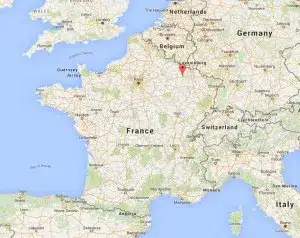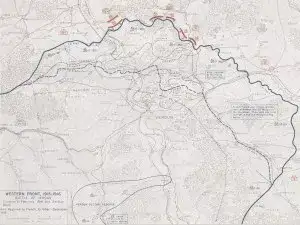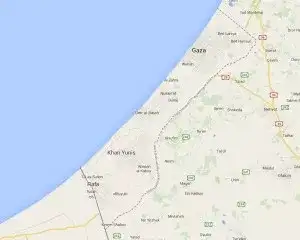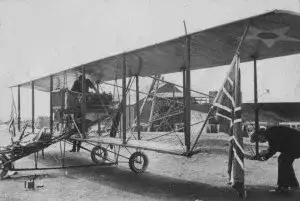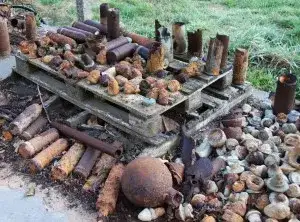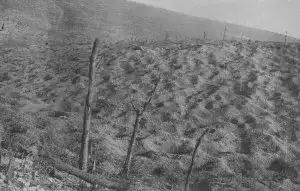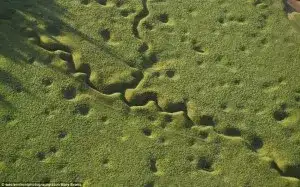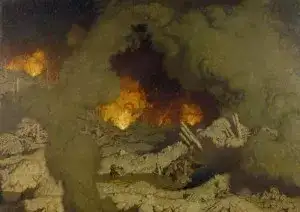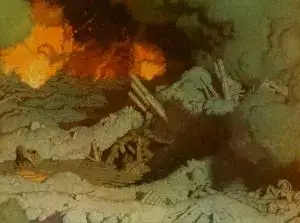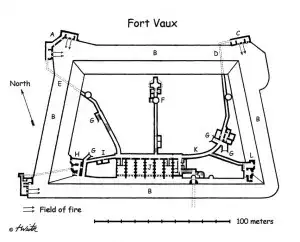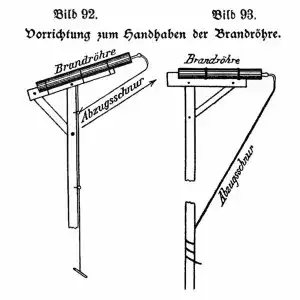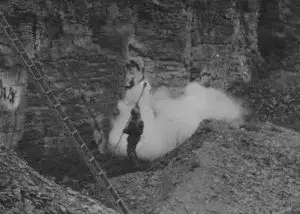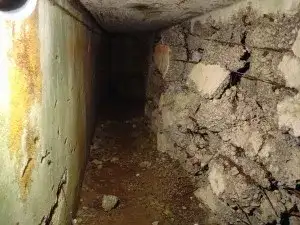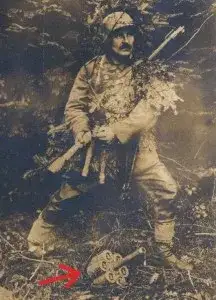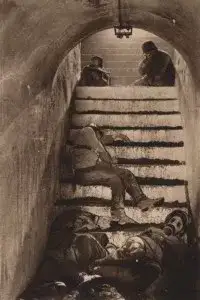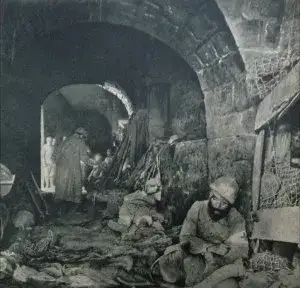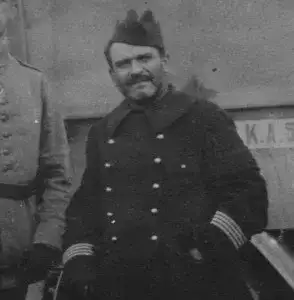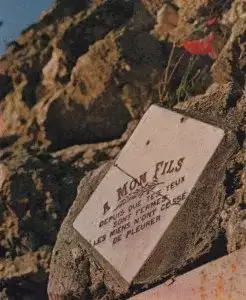Context: Here’s how “civilized” westerners used to fight
January 30, 2024 by Thomas Wictor
While we wait to see what’ll happen in Syria, Iraq, and the rest of the Middle East, here’s some context for the fighting. In five years, about 250,000 have been killed in the Syrian civil war. In comparison, from February to December of 1916, over 300,000 combatants were killed in the Battle of Verdun. Nobody’s bothered to even estimate the number of civilians killed.
Here’s where the Battle of Verdun took place.
About 300,000 men were killed over ten months in a front 25 miles (40 kilometers) wide as the crow flies.
That’s the approximate width of the Gaza Strip.
I calculate by adding up figures from dozens of sources that about 15,000 Gazans have been killed in war since 1948.
In ten months, a minimum of 300,000 were killed on the Verdun front. Over 68 years, a maximum of 15,000 have been killed on the Gaza front.
Context. Remember it the next time someone accuses Israel of genocide.
Weapons in context
During the Battle of Verdun, aircraft played almost no role in the killing. Fliers served as artillery observers and intelligence officers. The aircraft of the day could drop only small bombs or strafe with machine guns.
In Syria, a single jet fighter is more destructive than an entire air force was in 1916.
However, Verdun must be viewed in another context: The opposing sides fired over 45 million artillery rounds. So many were duds that to this day, entire regions of France are cordoned off. They’re simply too dangerous to enter. A century later, these munitions still kill people. The French and Belgian explosive-ordnance disposal (EOD) technicians are the most experienced in the world. Every year the French have the “iron harvest.”
These are only the munitions that got in somebody’s way. At the rate the French are going in removing the unexploded ordnance (UXO) from the former battlefields, the country will be completely clear in another two centuries.
Context. It’s useful, isn’t it?
This was what Verdun looked like at the end of the battle.
There was absolutely nothing left.
Here’s Verdun today.
The earth at Verdun became completely soaked in blood and fragments of corpses that were chopped up by shellfire over and over and over until the living soldiers were wading waist deep in gore and mud. The war artist Georges Leroux captured it in his painting L’Enfer (Hell).
The worst combat experience in human history took place in Verdun, at Satan’s outpost Fort Vaux.
Even in context, it can’t be imagined
Fort Vaux was built in 1881 to 1884 and was obsolete by 1916. This didn’t stop the French from defending it or the Germans from taking it.
The smallest of the defensive fortifications at Verdun, it was protected by a wide moat (B) with detached concrete installations in the corners. These were the flanking galleries, which were connected to the main body of the fort by underground tunnels. The flanking galleries were armed with cannons and machine guns to engage enemy troops crossing the moat.
At 5:00 a.m. on June 2, 1916, German engineers climbed on top of the double flanking gallery in the northwest corner of the fort. They used rope to lower baskets of explosives and bundles of hand grenades that knocked out the guns, and then they assaulted the loopholes with horrific devices called “fire tubes”—sheet-metal cylinders filled with incendiary material and attached to long booms. When a lanyard was pulled, the fire tube belched a seven-foot (two-meter) jet of flame and clouds of choking smoke. It burned for 90 seconds.
By the afternoon, the Germans had overrun the flanking galleries in the northwest and northeast corners, and they had established machine-gun positions on the fort’s roof. Once inside the galleries, the Germans had access to the western and eastern tunnels. These led into the fort’s central corridor, which lay near the barracks and branched off into tunnels connected to the two bunkers in the southern corners, as well as the passageway to the commandant’s observation turret, where Colonel Sylvain Eugène Raynal holed up.
At 8:00 p.m, the Germans sent assault waves into the western and eastern tunnels, concrete passageways 35 inches (89 cm) wide and 60 inches (152 cm) tall.
Tunnels! Israelis know all about them, but in a different context.
In the passageways, the French had set up sandbag barricades, defended with machine guns and hand grenades. The Germans crawled forward under heavy fire and used grenades and demolition charges on the sandbags. When a barricade was breached, men engaged in fierce hand-to-hand combat with pistols, pickaxes, rifle butts, daggers, boots, and teeth. The fighting took place in pitch darkness filled with smoke, cordite fumes, and concrete dust.
Outside, the French army attempted five times to send reinforcements to the besieged fort. The Germans beat back each assault, inflicting heavy casualties.
After a day and a half of underground combat in the darkened fort, the Germans requested that flamethrowers be sent down. They arrived on June 4, 1916. The first flamethrower attack was carried out at 12:30 p.m. in the western tunnel. Three of these weapons were fired simultaneously at a barricade.
The men behind the barricade retreated, allowing the Germans to knock down the sandbags. They discovered that they were faced with a stairway. At the top, a machine gun fired on them, and the French hurled dozens of hand grenades. To escape the bullets and grenade fragments, the Germans had to cover themselves with burning sandbags.
When the firing stopped, the Germans built their own sandbag barricade. They’d taken 27 yards (25 meters) of corridor, including a stairway leading to the surface. This provided the assault squads with a short, protected connection to the roof of the fort. Half of the engineers who took the corridor were wounded, and all were suffering from smoke poisoning when they emerged on the roof with blackened faces and scorched clothing.
The smoke from the flamethrowers filled the entire fort. In the barracks, the French were forced to put armor plate over the windows, cutting off the flow of fresh air. The Germans attacked the armor with explosives and bundled hand grenades.
A French lieutenant named Girard manned a machine gun behind a burning sandbag barricade, driving the Germans back. By this time there was so little oxygen left in the air because of flamethrower smoke, fire-tube smoke, hand-grenade smoke, gunpowder smoke, and carbon dioxide that all the kerosene lamps in the fort went out and couldn’t be lit again. The French and Germans fought in total darkness for three more days.
While the western tunnel was being contested, the Germans sent a shock troop of engineers, infantrymen, and three flamethrower squads into the eastern tunnel. They arrived at a concrete stairway of fifty-one steps, at the top of which was a sandbag barricade. A flamethrower squad climbed the stairs and directed its flame jets upward. Rags, sandbags, packs, and pieces of clothing in the stairway caught fire, and thick smoke filled the narrow passageway, causing the Germans to vomit as they attacked.
The French continually threw hand grenades that rolled down the stairs and detonated among the Germans, who pushed ahead and left their wounded behind.
At the top of the stairs, the Germans breached the barricade and forced the French back deep into the fort, almost to the overflowing latrines. Hours after the fires caused by the flamethrowers were extinguished, the smoke continued to pour out of the tunnel. Both the Germans and the French built sandbag barricades to keep out the fumes.
The smoke was so thick that men instantly passed out if they took off their gas masks. At the latrines, the Germans shouted in French, “Surrender, or you’ll all be killed!”
Their answer was a volley of French hand grenades. Despite this apparent bravado, the French were panicking. Men tore down the armor plate over the barracks windows and jumped to their deaths in the moat below. Nobody could breathe.
Hell in context
French commander Raynal described June 5, 1916, as the “Day of Hell.” At 5:00 a.m. German engineers on the roof of the fort blew a hole in the passageway to the southwestern bunker and poked fire tubes inside. However, since the interior of the fort was so hot and airless, the hole created a massive updraft that caused the smoke and flames to rush back into the faces of the Germans.
Two more shock troops of engineers on the roof used explosives to puncture the eastern tunnel. When they put in fire tubes, the same thing happened: The flames roared out and burned them. All attempts to enter by blowing holes in the tunnels were unsuccessful.
Four flamethrower squads and a shock troop of engineers then attacked the southwestern bunker at 9:00 a.m. The French somehow stood their ground and repelled the assault troops with hand grenades and machine guns.
By June 5, the French had not had water for three days. They were licking the walls and drinking their own urine. In the summer heat, the piled-up corpses decomposed rapidly, adding their stench to the miasma of smoke, latrines, and unwashed bodies.
On the morning of June 6, 1916, the Germans decided to stop using flamethrowers and fire tubes inside the fort. Germans were now dying of asphyxiation, and the weapons caused as much terror among the attackers as the defenders. The French held out for one more day, and then at 6:00 a.m. on June 7, Raynal surrendered the fort.
He was taken to Crown Prince Wilhelm, who gave Raynal a replacement sword for the one he’d handed over at the fort. Thus armed, the middle-aged colonel—who’d been so severely wounded in 1914 that he’d been discharged from the army but then volunteered to fight again—was whisked off into captivity. The photo below was taken moments after Raynal surrendered.
The parched French defenders of the fort emerged and ran to the nearest water-filled shell hole to drink. They’d suffered fewer than 100 casualties, while the Germans lost 2700.
This plaque was placed on the ruins of Fort Vaux after the war.
“To my son. Since your eyes closed, mine have not ceased to cry.”

